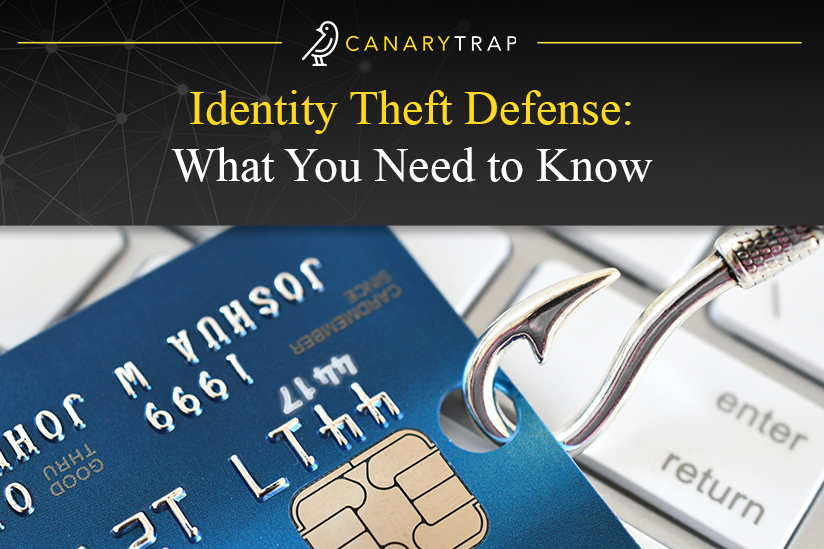Identity Theft Defense: What You Need to Know
- May 24, 2024
- Canary Trap
In today’s digital age, identity theft has become a pervasive threat, with millions of individuals falling victim to its devastating consequences each year. This malicious act involves the unauthorized use of someone else’s personal information, such as their name, Social Security number, or financial details, for fraudulent purposes. From fraudulent credit card charges to unauthorized bank account access, the impact of identity theft can be far-reaching, causing financial loss, emotional distress, and damage to one’s reputation.
According to recent statistics, identity theft affects millions of people worldwide annually, making it one of the fastest-growing crimes globally. With advancements in technology and the increasing digitization of personal data, identity thieves have more opportunities than ever to exploit vulnerabilities and steal sensitive information. As such, safeguarding personal information has never been more critical. By understanding the prevalence of identity theft and its potential consequences, individuals can take proactive steps to protect themselves and their loved ones from falling victims to this pervasive threat. Join us as we explore some practical strategies for recognizing signs of identity theft, protecting personal information, and responding effectively if identity theft occurs.
Understanding Identity Theft
Identity theft is a malicious act wherein someone unlawfully obtains and uses another person’s personal information, such as their name, Social Security number, or credit card details, without their permission. This stolen information can be used to commit various fraudulent activities, including unauthorized financial transactions, opening new lines of credit, or accessing sensitive accounts.
Identity thieves employ various methods to obtain personal information, such as phishing emails, data breaches, social engineering tactics, and stealing physical documents like mail or wallets. Once they acquire this information, they can use it to impersonate the victim, potentially causing significant financial and emotional harm.
As it was mentioned in an article published by Investopedia, “identity thieves increasingly use computer technology to obtain other people’s personal information for identity fraud. To find such information, they may search the hard drives of stolen or discarded computers; hack into computers or computer networks of organizations and corporations; access computer-based public records; use information-gathering malware to infect computers; browse social networking sites; or use deceptive emails or text messages.”
The consequences of identity theft can be devastating for victims. Financially, victims may incur unauthorized charges, have their bank accounts drained, or suffer damage to their credit scores due to fraudulent activity in their name. Additionally, resolving identity theft can be a lengthy and arduous process, requiring victims to dispute fraudulent charges, freeze their credit reports, and work with financial institutions to restore their identities and creditworthiness.
Moreover, identity theft can have far-reaching consequences beyond financial loss. Victims may experience emotional distress, anxiety, and a loss of trust in institutions responsible for safeguarding their personal information. Furthermore, identity theft can damage a victim’s reputation and lead to issues with employment, housing, or other aspects of their personal and professional life.
Understanding the nature of identity theft, its common methods, and its potential consequences is essential for individuals to recognize any signs of an attack, take proactive measures to protect their personal information, and respond effectively if they become victims of this pervasive crime.
Recognizing Signs of Identity Theft
Identifying signs of identity theft early is crucial for mitigating its impact and taking prompt action to address any unauthorized activity. Here are some common warning signs that may indicate your identity has been compromised:
- Unexplained Financial Activity
Keep an eye out for unfamiliar charges on your bank statements or credit card bills. These could include purchases you didn’t make or withdrawals from your accounts that you didn’t authorize.
- Missing Mail or Statements
If you stop receiving important financial statements or bills in the mail, it could be a sign that someone has changed your mailing address to intercept sensitive information.
In fact, the office of the Attorney General of Texas, for example, recommends that “If you receive bills and financial statements by mail, be aware of when they normally arrive each month. Call the company if they don’t arrive on time. Statements may be missing because someone has changed your mailing addresses to hide fraudulent charges.”
- Sudden Changes in Credit Score
Monitor your credit report regularly for any unexpected fluctuations in your credit score, which could indicate that someone has opened new accounts or taken out loans in your name.
- Notification of Account Changes
If you receive notifications from financial institutions or service providers about changes to your accounts that you didn’t initiate, such as password resets or address changes, it could be a red flag for identity theft.
- Rejection of Credit Applications
If you’re unexpectedly denied credit or encounter difficulties opening new accounts, it may be due to fraudulent activity on your credit report.
Recognizing signs of identity theft early is crucial for mitigating its impact and taking prompt action to address any unauthorized activity. By remaining vigilant and monitoring your financial accounts and credit report regularly, you can catch suspicious activity before it escalates. It’s important to act quickly by reporting the suspected identity theft to the relevant authorities and taking steps to protect your personal information from further harm.
Protecting Your Personal Information
Preventing identity theft requires a multifaceted approach that encompasses various strategies aimed at minimizing the risk of unauthorized access to personal information. Here are some practical tips for protecting your sensitive data both online and offline:
- Use Strong, Unique Passwords
Create strong and unique passwords for each of your online accounts, incorporating a mix of letters, numbers, and special characters. Avoid using easily guessable information, such as your name or birthdate, and consider using a reputable password manager to securely store and manage your passwords.
Regarding that fact, Security.org considers passwords managers a must. They explain that: “Most of us have multiple online accounts, and it’s not a good idea to use the same passwords for all of them. If you have the same password for your email and banking accounts, for instance, a criminal only needs to find out one password to access both accounts. That’s where password managers come in. Password managers are services or apps that create strong passwords and store them in encrypted digital vaults.”
- Enable Multi-Factor Authentication (MFA)
Whenever possible, enable multi-factor authentication on your accounts to add an extra layer of security. MFA requires you to provide additional verification, such as a code sent to your phone or email, when logging in to your accounts.
- Be Mindful of Phishing Attempts
Stay vigilant against phishing attempts by carefully scrutinizing emails, messages, and websites for signs of suspicious activity. Avoid clicking on links or downloading attachments from unknown or untrusted sources, and be cautious when providing personal information online.
- Secure Your Devices
Keep your devices, including computers, smartphones, and tablets, up to date with the latest security patches and software updates. Install reputable antivirus and anti-malware software to protect against malicious threats, and consider using encryption to secure your sensitive data.
- Limit Information Sharing
Be cautious about sharing personal information online and on social media platforms. Avoid oversharing details such as your address, phone number, or financial information, and review privacy settings to control who can access your personal data.
- Use Secure Connections
When accessing the internet, use secure connections whenever possible, such as encrypted HTTPS websites. Avoid using public Wi-Fi networks for sensitive transactions, as they may be susceptible to interception by cybercriminals.
Microsoft recommends being defensive with sensitive information: “Before you enter sensitive data, check to ensure the web address starts with https (“s” stands for secure) and shows a closed padlock. (The lock might also be in the lower right corner of the window.)”
- Work with Identity Theft Protection Services
Apart from individual efforts, leveraging identity theft protection services and credit monitoring can provide valuable assistance in detecting and mitigating potential threats. These services typically offer real-time monitoring of credit reports and alert users to any suspicious activity, enabling prompt action to address potential identity theft incidents. While such services may involve a cost, the investment can offer peace of mind and potentially save individuals from significant financial losses associated with identity theft.
By implementing these best practices and remaining vigilant in safeguarding your personal information, you can reduce the risk of identity theft and protect your privacy and security in an increasingly digital world.
Responding to Identity Theft
If you suspect your identity has been stolen, you should take immediate action to minimize further damage:
- Report the Incident
Contact your financial institutions and credit bureaus to report the identity theft. Place a fraud alert on your credit reports to alert potential creditors, and consider freezing your credit to prevent new accounts from being opened in your name.
- File a Report
File a report with your local law enforcement agency and the Federal Trade Commission (FTC) to document the identity theft and create a paper trail for potential legal action.
According to an article published by Medium “Initiating contact with the Federal Trade Commission (FTC) to officially report the incident and subsequently generating an Identity Theft Report is the crucial first step in combating identity theft. It is imperative to maintain meticulous records of all correspondence and steps taken to rectify identity theft issues, aiding in the documentation of the situation and facilitating recovery endeavors.”
- Monitor Your Accounts
Regularly monitor your bank and credit card statements for unauthorized transactions, and review your credit reports for any unfamiliar activity. Enrolling in identity theft protection services to receive alerts about suspicious activity is always helpful.
By taking swift and decisive action in response to identity theft, you can mitigate the impact of the incident and work towards restoring your identity and financial security. Remember to stay vigilant and proactive in protecting your personal information to prevent future incidents of identity theft.
In Conclusion
Safeguarding personal information from identity theft is a critical endeavor in today’s digital landscape. Throughout this blog post, we have explored the various facets of identity theft, including its definition, common methods used by perpetrators, and the potential consequences for victims. That’s why it was so important to understand the warning signs of identity theft, preventive measures, and steps to take if one suspects their identity has been compromised.
By implementing strategies such as securing sensitive information, using strong passwords, and leveraging identity theft protection services, individuals can significantly reduce their vulnerability to fraudulent activity. Furthermore, staying vigilant and informed about emerging threats is essential in maintaining robust identity theft protection and safeguarding personal information in this complex digital world.
SOURCES:
- https://www.investopedia.com/terms/i/identitytheft.asp
- https://www.texasattorneygeneral.gov/consumer-protection/identity-theft/help-prevent-identity-theft
- https://www.security.org/identity-theft/protection/
- https://support.microsoft.com/en-us/office/protecting-yourself-from-identity-theft-online-6019708f-e990-4894-9ca7-fdb53ee70830
- https://medium.com/@stephen.wycoff/protecting-your-identity-essential-strategies-to-prevent-identity-theft-9abc6a8a054b

